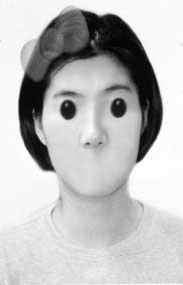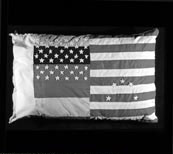
School News
The Color of Art
Interrogating Diversity at Betty Rymer Gallery
By Michele Heidel
The word "diversity" has infiltrated so many areas of life that one would assume that an idea
so tantalizing is the accepted standard for society. However, as colleges and universities across
the nation struggle to diversify their populations, SAIC has its own special challenges when it
comes to the issue of diversity. Just what does the subject of diversity have to do with art?

|
|
Inhee Jung,Being Kittyed
Photo courtsey of the artist.
|
The juried exhibition Interrogating Diversity at the Betty Rymer Gallery focuses on this question
and more; the artwork attempts to interpret the different meanings diversity has and how they are
manifested in art.
Many of the artworks in the show address "displacement" more than "diversity," suggesting that
movement and relocation are the catalysts to an ever-shifting social identity; diversity does not
happen to a place, it happens because of the place.
Anaida Hernandez's "La Tercera Fuga—The Third Escape," is an installation of three printed panels
and a circle of salt, lit with black lights and embedded with footprints. These footprints are
representative of people seeking a life in another place. They are evidence that many cultures
are converging in places that may not be able to hold them.
Diversity in a political/geographical sense holds true in a photo-documented performance by Athanasia
Kyriakakos, a Greek woman, and Turhan Karabey, a Turkish man. Through the literal washing of hands,
the two symbolically cleanse the history of violence between their cultures. Another cross-cultural
bridge was formed by Joan Fabian and her printed email exchanges with Pakistani artists. A few
examples of art that Fabian and her correspondents produced are displayed next to the printouts on
a wall of voluptuous imagery. With the images, it is easy to understand why Fabian is so enamored
of Pakistan's citizens—kindness and affection are evident in the correspondences, particularly in
those dated after September 11.
The exhibition's attempt to examine diversity is conveniently timed with the current patriotic
climate in the United States, as witnessed in the spectacle of Super Bowl XXXVI and the Olympics
in Salt Lake City. At a time when one who questions or refuses to take part in the patriotic fervor
is considered to be a social misfit, some works in the exhibition have striking relevance.
Lukluk Galeb's series of prints, "Green Tea in a Coke Bottle," shows the stages of a Coke bottle
filled with specific measurements of green tea. Poetry underneath reveals how one's identity
(represented by the tea) must conform to the shape of the quintessential image of Western culture.

|
|
Rafael VeraCulture Comfort
Photo courtsey of the artist.
|
D. Denenge Akpem's collection of family photographs hangs wistfully among stringed beads, creating
an inquisitive sense of nostalgia. These works, like many in the exhibition, stress the preservation
of the individual among social alteration.
Perhaps the subtlest understanding of diversity comes in the obvious interpretation of opposites
—black/white, male/female, American/non-American, gay/straight, able/disabled, East/West. This
is where the wittier, humorous works are strongest in their analysis.
In her video, Verlena Johnson sings Queen's "Bohemian Rhapsody," paying tribute to the music she
listened to as a teenager. She and her sinister alter-ego, marionette Troy, wander through a
Midwest forest and along train tracks questioning the idea of "whiteness." In Yun Jo's video,
Korean men (who claim they are not stereotypically male) try in vain to reproduce feminine gestures
with amusing results. The men attempt to smile like a bride, apply mascara, and sit politely on
the subway, awkwardly imitating the women they watch on a monitor. Perhaps these artists are
letting us know that it is not enough to criticize current social and sexual definitions; we must
be able to laugh at them as well.
While diversity is what many societies hope for, it is unclear which forms they are willing to
tolerate—racial, sexual, economic, physical, or religious—and at what levels.
Although it is a burdensome request to ask any exhibition to cover the implications of diversity,
these works contain both a subtle reasoning and a longing plea for intelligent approaches to
diversity. The viewer is left to contemplate diversity and its existence in society, and hopefully
to question the idea as well.
| 
